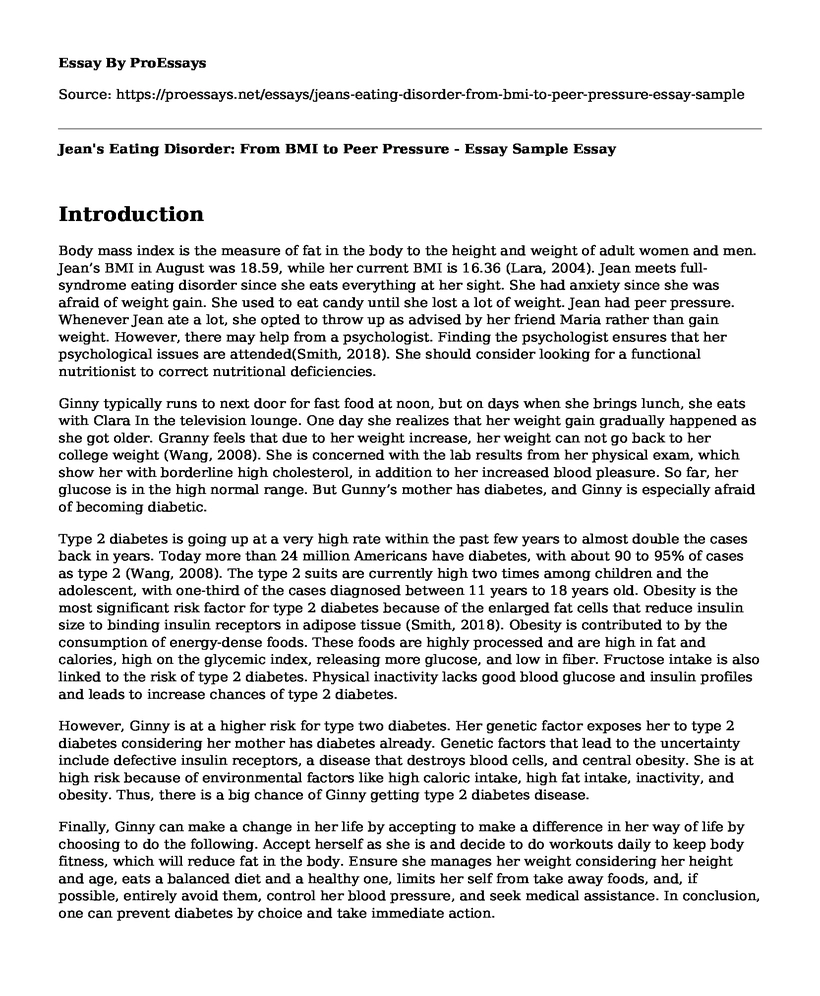Introduction
Body mass index is the measure of fat in the body to the height and weight of adult women and men. Jean’s BMI in August was 18.59, while her current BMI is 16.36 (Lara, 2004). Jean meets full-syndrome eating disorder since she eats everything at her sight. She had anxiety since she was afraid of weight gain. She used to eat candy until she lost a lot of weight. Jean had peer pressure. Whenever Jean ate a lot, she opted to throw up as advised by her friend Maria rather than gain weight. However, there may help from a psychologist. Finding the psychologist ensures that her psychological issues are attended(Smith, 2018). She should consider looking for a functional nutritionist to correct nutritional deficiencies.
Ginny typically runs to next door for fast food at noon, but on days when she brings lunch, she eats with Clara In the television lounge. One day she realizes that her weight gain gradually happened as she got older. Granny feels that due to her weight increase, her weight can not go back to her college weight (Wang, 2008). She is concerned with the lab results from her physical exam, which show her with borderline high cholesterol, in addition to her increased blood pleasure. So far, her glucose is in the high normal range. But Gunny’s mother has diabetes, and Ginny is especially afraid of becoming diabetic.
Type 2 diabetes is going up at a very high rate within the past few years to almost double the cases back in years. Today more than 24 million Americans have diabetes, with about 90 to 95% of cases as type 2 (Wang, 2008). The type 2 suits are currently high two times among children and the adolescent, with one-third of the cases diagnosed between 11 years to 18 years old. Obesity is the most significant risk factor for type 2 diabetes because of the enlarged fat cells that reduce insulin size to binding insulin receptors in adipose tissue (Smith, 2018). Obesity is contributed to by the consumption of energy-dense foods. These foods are highly processed and are high in fat and calories, high on the glycemic index, releasing more glucose, and low in fiber. Fructose intake is also linked to the risk of type 2 diabetes. Physical inactivity lacks good blood glucose and insulin profiles and leads to increase chances of type 2 diabetes.
However, Ginny is at a higher risk for type two diabetes. Her genetic factor exposes her to type 2 diabetes considering her mother has diabetes already. Genetic factors that lead to the uncertainty include defective insulin receptors, a disease that destroys blood cells, and central obesity. She is at high risk because of environmental factors like high caloric intake, high fat intake, inactivity, and obesity. Thus, there is a big chance of Ginny getting type 2 diabetes disease.
Finally, Ginny can make a change in her life by accepting to make a difference in her way of life by choosing to do the following. Accept herself as she is and decide to do workouts daily to keep body fitness, which will reduce fat in the body. Ensure she manages her weight considering her height and age, eats a balanced diet and a healthy one, limits her self from take away foods, and, if possible, entirely avoid them, control her blood pressure, and seek medical assistance. In conclusion, one can prevent diabetes by choice and take immediate action.
References
Lara-Esqueda, A., Aguilar-Salinas, C. A., VelazquezMo nroy, 0., Gomez-Perez, F. j., Rosas-Peralta , M.,Mehta, R., et al. (2004). The body mass index ts a\ess-sensiti\'e tool for detecting cases with obesityassoc1ated co-morbidities 111 shon stature subjects.
Smith, B., & McGannon, K. R. (2018). Developing rigor in qualitative research: Problems and opportunities within sport and exercise psychology. International review of sport and exercise psychology, 11(1), 101-121.
Wang, Y., Beydoun, M.A., Ltang, L., Caballero, B .. &Kumanyika, S.K. (2008). Will all Americans become over weight or obese? Esumating the progression and cosL of the US obesity epidemic. Obesity, 16(10), 2323-2330.
Cite this page
Jean's Eating Disorder: From BMI to Peer Pressure - Essay Sample. (2023, Aug 02). Retrieved from https://proessays.net/essays/jeans-eating-disorder-from-bmi-to-peer-pressure-essay-sample
If you are the original author of this essay and no longer wish to have it published on the ProEssays website, please click below to request its removal:
- Essay on Public Health: The Impact of Society on Health of the Individual with Fibromyalgia
- Paper Example on Conscientiousness
- Description of Positive Emotion Essay
- Essay Sample on How Filmmakers Can Push Our Buttons Emotionally
- Essay Sample on Finding Comfort Outside My Comfort Zone: A Journey to Self-Discovery
- Paper Example on Unresolved Loss: Monica McGoldrick's Sessions with the Rogers Family
- Essay Example on Child Abuse: Unveiling Causes of a Contentious Issue







